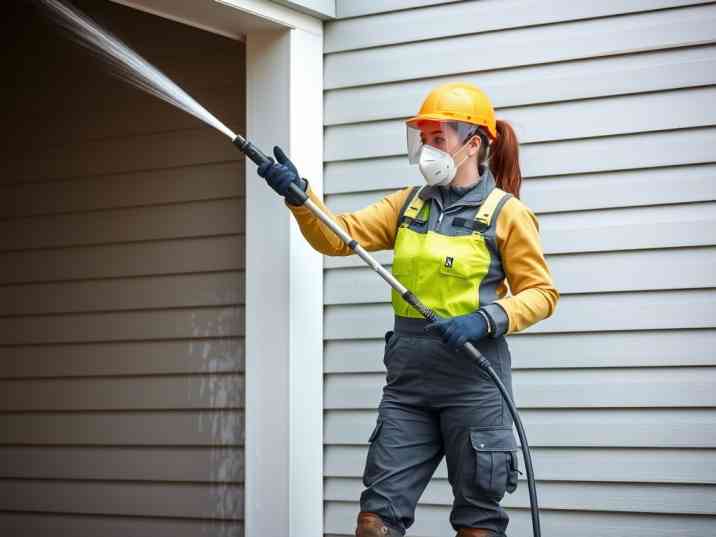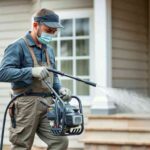Power washing, also known as pressure washing, is a popular cleaning method that uses high-pressure water to remove dirt, grime, mold, and stains from various surfaces. While it’s an effective solution for maintaining homes, driveways, and commercial properties, several misconceptions surround its use. These misunderstandings can deter people from utilizing power washing correctly or safely, potentially leading to suboptimal results or damage. This article debunks the top common misconceptions about power washing, providing detailed explanations to clarify the facts and empower users with professional insights for optimal outcomes.
Misconception 1: Power Washing and Pressure Washing Are the Same Thing
One of the most widespread misconceptions is that power washing and pressure washing are identical processes. While the terms are often used interchangeably, they differ in a key aspect: power washing incorporates heated water, whereas pressure washing relies solely on high-pressure cold water. This distinction is critical because it affects their applications and effectiveness.

Pressure washing uses water at ambient temperature, typically delivered at 1,200-4,000 PSI (pounds per square inch), making it suitable for removing loose dirt, dust, and light stains from surfaces like concrete or vinyl siding. Power washing, however, adds heat—often exceeding 200°F—to tackle tougher contaminants like grease, oil, or deeply embedded grime, which cold water alone struggles to break down. For example, a power washer is ideal for degreasing industrial equipment, while a pressure washer suffices for a residential deck.
Understanding this difference helps users choose the right tool for the job. Misapplying a pressure washer on oily stains or a power washer on delicate wood can lead to inefficiency or damage. By debunking this myth, users can make informed decisions based on the specific cleaning needs of their surfaces.
Misconception 2: Power Washing Is Safe for All Surfaces
A common belief is that power washing is a one-size-fits-all solution for any surface, from brick walls to car exteriors. In reality, the high pressure and heat involved can harm delicate or improperly prepared materials, leading to costly repairs. This misconception often stems from overconfidence in the tool’s versatility without considering surface-specific requirements.
For instance, soft woods like cedar or pine can splinter or warp under excessive pressure (above 1,500 PSI), while painted surfaces may peel if not cleaned with a wide-angle nozzle (e.g., 40-degree). Similarly, asphalt shingles on roofs can loosen or crack under high PSI, allowing water infiltration. Delicate materials like stucco or older masonry also risk erosion if not handled with care. Even durable surfaces like concrete require caution—unsealed concrete can absorb too much water, leading to cracking over time.
The truth is that power washing is safe only when tailored to the surface. Professionals recommend testing a small, inconspicuous area first, using adjustable pressure settings (starting at 1,200 PSI) and appropriate detergents. This misconception underscores the importance of research and technique, ensuring surfaces remain intact and pristine post-cleaning.
Misconception 3: You Don’t Need Detergents for Effective Power Washing
Many assume that the sheer force of water in power washing eliminates the need for detergents, relying solely on pressure to clean. While pressure alone can dislodge loose debris, this belief overlooks the role of detergents in tackling stubborn or organic stains, leading to incomplete results.
Water pressure excels at removing surface-level dirt, but contaminants like mold, mildew, grease, or oil require chemical assistance to break their bonds with the surface. For example, mildew on a wooden deck may appear removed by pressure, but its roots can remain embedded without a biocide-containing detergent, allowing regrowth. Grease on a driveway similarly resists water alone, as its hydrophobic nature repels cold water—heated power washing with a degreaser is far more effective.
Using the right detergent enhances efficiency and protects surfaces. Biodegradable options like Simple Green or specialized concrete cleaners penetrate stains, reducing the need for excessive pressure that could damage materials. Debunking this myth highlights that detergents are a critical complement to power washing, ensuring thorough, long-lasting cleanliness.
Misconception 4: Power Washing Is a DIY Task Anyone Can Do Without Training
The accessibility of power washers at hardware stores fuels the misconception that anyone can use them effectively without training. While they’re user-friendly for basic tasks, improper handling can lead to property damage, injury, or subpar results, making some knowledge essential.
Operating a power washer involves more than pointing and spraying. Users must understand PSI settings—1,200 PSI for wood versus 3,000 PSI for concrete— and nozzle selection (e.g., 25-degree for general cleaning, avoiding 0-degree for its pinpoint intensity). Incorrect technique, like holding the wand too close (under 6 inches) or at a perpendicular angle, can gouge surfaces or strip paint. Safety risks also loom—high-pressure water can cut skin, and kickback from the wand can cause falls if not braced properly.
Training, even self-guided via manuals or online tutorials, teaches critical skills: maintaining a 30-45-degree angle, working with the grain on wood, and wearing protective gear like goggles and gloves. For complex jobs (e.g., multi-story siding), hiring a professional may be wiser. This myth’s debunking emphasizes preparation and respect for the tool’s power, ensuring safe, effective outcomes.
Misconception 5: Power Washing Instantly Improves Property Value
A pervasive belief is that power washing automatically boosts a property’s value by enhancing curb appeal. While it can improve aesthetics, this misconception exaggerates its impact on market worth and overlooks underlying factors that appraisers consider.
Power washing a dirty driveway or algae-covered siding undoubtedly refreshes a property’s appearance, potentially attracting buyers or tenants. A 2023 National Association of Realtors report noted that exterior improvements, including cleaning, can yield a 5-10% increase in perceived value. However, actual appraised value hinges on structural integrity, location, and upgrades like HVAC—not just cleanliness. A pristine exterior won’t offset a leaking roof or outdated interiors.
Moreover, over-washing or damaging surfaces (e.g., stripping sealant) can lower value by necessitating repairs. The truth is that power washing is a maintenance tool, not a value miracle. It enhances appeal and preserves condition when done right, but expecting instant equity gains oversimplifies real estate dynamics.
Misconception 6: Power Washing Is Environmentally Harmful
Some hesitate to use power washing, believing it’s inherently bad for the environment due to water usage and chemical runoff. While misuse can pose risks, this misconception ignores modern practices that make power washing eco-friendly when executed responsibly.
Water consumption is a concern—pressure washers use 2-8 gallons per minute (GPM), compared to a garden hose’s 5-10 GPM—but they clean faster, often reducing total usage. For example, a 10-minute power washing job at 2 GPM uses 20 gallons, versus 50-100 gallons with a hose. Newer models also feature water-saving technology, further minimizing waste.
Runoff from detergents is another issue, but biodegradable, non-toxic cleaners (e.g., Krud Kutter Green) mitigate harm to plants and waterways. Containing wastewater with tarps or vacuums, as required in some municipalities, prevents contamination. Debunking this myth reveals that with proper equipment and techniques, power washing aligns with sustainable practices, balancing efficacy with environmental care.
Misconception 7: Power Washing Requires No Maintenance or Prep Work

A final misconception is that power washing is a quick fix requiring no prep or follow-up. In truth, preparation and maintenance are vital to protect surfaces and ensure lasting results, debunking the idea of it as an effortless cure-all.
Pre-washing steps include clearing debris (e.g., sweeping leaves), covering plants or outlets, and pre-wetting wood to limit water absorption. Skipping these can lead to clogged nozzles or unintended damage. Post-washing, surfaces like decks may need sanding if grain raises, or sealing to prevent moisture infiltration—unsealed concrete can crack if water seeps in and freezes.
Maintenance extends to the equipment: rinsing detergent residue, storing hoses properly, and winterizing the pump prevent breakdowns. This myth’s clarification underscores that power washing is a process, not a one-off task, requiring diligence for optimal performance and surface longevity.
Conclusion
Power washing is a valuable cleaning method, but misconceptions can cloud its benefits and risks. By distinguishing power from pressure washing, recognizing surface limits, valuing detergents, respecting training needs, tempering value expectations, embracing eco-friendly options, and acknowledging prep work, users can approach it with clarity and confidence. Debunking these myths empowers homeowners and professionals alike to harness power washing effectively, achieving spotless results without pitfalls. With the right knowledge, this tool becomes a reliable ally in property maintenance, dispelling doubts and delivering professional-grade cleanliness.




